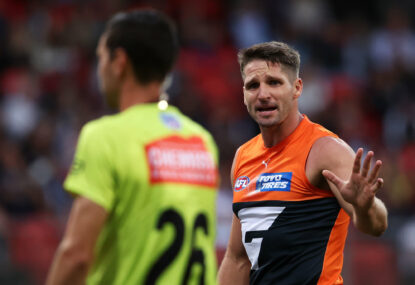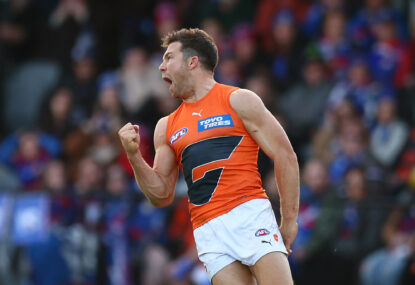It’s official – the GWS Giants are headed for their first finals series.
Their 88-point thrashing of Richmond in Canberra, their 13th victory for the season, has all but booked the fifth-year club its maiden September berth, completing a long and sometimes difficult journey from the very early days of regular thrashings to the powerhouse the AFL expected them to become when they were formed.
The match was virtually over by quarter-time, by which point the Giants had kicked eight goals to nil, and eventually Leon Cameron’s men would kick a total of 17 majors for the match while keeping the Tigers to just three.
The Tigers’ score of 3.5 (23) is the lowest score ever conceded by the Giants, which in their first few years copped some heavy scores against them as they fielded a severely inexperienced side.
But the additions in the subsequent seasons of experienced campaigners such as Heath Shaw, Shane Mumford, Ryan Griffen, Joel Patfull and Steve Johnson, among others, has fast-tracked the club’s on-field competitiveness and it’s fair to say that the days of the heavy defeats are well and truly over.
To put all that into context, it seemed like only yesterday that the Giants were on the wrong end of a 113-point humiliation at the hands of the Tigers, a defeat which made the club, then 53 games old, take a seriously good look at itself in the mirror.
The club went out on the record admitting they were uncompetitive, but knew exactly where they were at and were embarking on a path that will eventually take them to their first finals series this year.
In terms of the number of matches the Giants have played since playing their first ever match in Round 1, 2012, that was half their current lifetime ago. Their win over the Tigers in Round 19 this year came in their 106th match.
Since that heavy loss way back in Round 10, 2014, which many including myself believe could’ve been the turning point in the Giants’ history going forward, the club has won 28 of 53 games – for a win rate of just over 50 per cent.
Their heaviest defeat since then was an 89-point loss to cross-town rivals the Sydney Swans late last season, when injuries to key players saw the club tumble from a 7-3 record after Round 10 to a final placing of 11th with an 11-11 record.
By contrast, they only sung the team song just five times in their first 53.
The win over the Tigers saw the Giants maintain second place on the ladder on percentage, only behind first-placed Hawthorn, and with an easy run home to follow in the next month, the club is well poised to host a home final in the first fortnight of the finals series, if not the first week.
Their run home sees them face the Gold Coast Suns, West Coast Eagles, Fremantle and North Melbourne, with only the match against the Roos in the final round the only one in which they probably won’t start as favourites.
Still, should they beat the Suns, Eagles and Dockers in the next three weeks as expected, they’ll have 16 wins by the time they face the Roos at Etihad Stadium on Saturday, August 27.
That match could ultimately decide where the Giants finish on the ladder, especially as, entering Round 19, they shared equal second place with the Geelong Cats, Sydney Swans, West Coast Eagles, Adelaide Crows and Western Bulldogs.
The Bulldogs and Eagles both lost their respective ties to the Cats and Pies so far this weekend, with the Cats joining the Giants on 13 wins for the season. The Swans and Crows will be expected to join the pair on as many wins and in equal second place when they face Fremantle and Essendon today.
However, it’s the Giants who sit behind reigning premiers Hawthorn on the ladder with the best percentage and best attack* of any team in the competition – a far cry from their inaugural when they were ranked last in both categories.
That is what puts them in the box seat to host a home final in week one of the finals series, and while it is expected to be played at Spotless Stadium, there is the chance it could be moved to ANZ Stadium should they draw the Sydney Swans as their qualifying final opponent.
That would give the Swans the advantage as they have played way more games (and all but one of their home finals since 2003) at the Olympic venue more than the Giants (0-3 record, all losses against the Swans) ever have.
The club’s home attendances have been very strong this season, with only two matches (against the Gold Coast Suns and Western Bulldogs in Sydney) drawing less than 10,000 fans.
It helped that the club received a commercially friendly fixture this year, with blockbuster home games against Hawthorn, the Sydney Swans and Collingwood, as well as those in Canberra against the Geelong Cats and Richmond, all drawing strong five-figure crowds, with the match against the Swans drawing 21,541 fans.
Now that the club has just about punched their ticket to September, it will remain to be seen how they will be able to handle the heat of finals football.
The most recent expansion club to reach the finals, Port Adelaide in 1999**, did so in their third year in the competition after entering the AFL in 1997 but would end up on the receiving end of a 44-point defeat to eventual premiers North Melbourne.
Two years later, after earning the double chance they would crash out of the 2001 finals series in straight sets and despite finishing as minor premiers in 2002, 2003 and 2004, could only convert the latter year into a breakthrough premiership.
Their premiership win that year was made most famous when then-coach Mark Williams pretended to “choke” himself with a tie post-match, and made the famous remark on the podium: “Allan Scott, you were wrong!”.
That was a reference to the club being unable to win cut-throat finals matches in 2002 and 2003 when it lost qualifying final matches to Collingwood and the Sydney Swans respectively, both at home.
Most recently, and most notably, Richmond ended a finals drought of more than a decade when it finished fifth in 2013.
In the elimination final, they faced a Carlton side that was promoted to eighth place after Essendon were demoted following its controversial supplements program, and after leading by 31 points early in the third quarter faded badly to lose by 20 points.
They subsequently lost two further elimination finals to Port Adelaide and North Melbourne in 2014 and last year, respectively.
But while some crumble under the pressure of finals football, some thrive.
Look at Hawthorn in the mid-2000s as an example.
In 2007, after five years without finals football and in Alastair Clarkson’s third year as coach, the club finished fifth on the back of the emergence of superstars such as Lance ‘Buddy’ Franklin, Jarryd Roughead, Jordan Lewis, Luke Hodge and Sam Mitchell, among many others.
They faced the Adelaide Crows, who had reached the preliminary final in the previous two years, in the elimination final at Telstra Dome and Franklin would kick the match-winning goal, his eighth for the match, with just seconds remaining.
That was to be his coming of age, and while the Hawks lost their semi-final against the Kangaroos the following week it would only be the start of things to come.
Twelve months later they would finish second on the ladder and go on to face the grand final, where they faced reigning premiers the Geelong Cats, who had only been beaten once in the regular season (by 86 points against Collingwood).
Despite going in as underdogs, the Hawks would produce a massive upset to win by 26 points with Hodge winning the Norm Smith Medal as best on ground.
That completed their rags-to-riches rise after they were seemingly in ruins in 2004, when they finished 15th after then-coach Peter Schwab, who was sacked late that season, declared the club could win a premiership.
Though they would miss the finals the following year, since then the club has gone from strength to strength and this year are attempting to become just the second team (after Collingwood in 1927-30) to win a fourth consecutive flag.
Another team the Giants might want to consult ahead of their first finals series are their cross-town rivals, the Sydney Swans.
The Swans have proven to be the most consistent team of the past twenty years, missing the finals just three times since 1995 and reaching four grand finals, for a 2-2 record, during this period.
This included breaking their 72-year premiership drought, the longest in VFL/AFL history, in 2005, when they beat the West Coast Eagles by four points, and in 2012 when they defeated the red-hot favourites, Hawthorn, by ten points.
Not bad for a team that was at its lowest ebb in the mid-1990s, when they landed a hat-trick of wooden spoons and were seemingly on the verge of collapse before Ron Barassi was brought in to store some on-field competitiveness to the team.
Roughly two decades on from the establishment of one of the most consistent finals periods in recent AFL history, the Giants can create some finals history of their own this year.
Inexperience will be one huge obstacle to overcome, with most (if not all) of its playing list having not yet cracked 100 games and only a handful having experienced what it is like to play in September.
The most notable of them are Steve Johnson, who was part of the Geelong Cats’ classes of 2007, 2009 and 2011, winning the Norm Smith Medall in the former year, Heath Shaw, who featured in the 2010 Collingwood side, and Shane Mumford, who was an instrumental part of the 2012 Sydney Swans side.
Additionally, Callan Ward and Ryan Griffen were also part of the Western Bulldogs side that reached a hat-trick of preliminary finals between 2008 and 2010, during which current Giants coach Leon Cameron was the Bulldogs’ assistant coach.
The relationship between Griffen and Cameron was the catayst behind the former’s decision to request a trade to the Giants at the end of the 2014 season, while Ward was one of the club’s foundation players and is their fearless on-field leader today.
The acquisition of Griffen, as well as Joel Patfull from the Brisbane Lions, boosted the Giants’ on-field experience and last year they finished outside of the bottom three for the first time in their short history, finishing 11th with a record of 11-11.
They certainly could’ve played finals last year had Mumford not suffered a serious ankle injury against Collingwood at the MCG in Round 11, by which point they appeared to be flying at 7-4 (the loss to the Pies included).
But their goal of playing finals this year has been helped by the recruitment of Steve Johnson, who has cherished his move to western Sydney after being moved on by the Geelong Cats at the end of last season.
In saying that, he has added some experience to the club’s forward line, which boasts tall towers in Jonathan Patton, Jeremy Cameron and Rory Lobb. Collectively, the quartet have kicked 112 of the Giants’ goals this season, with Johnson contributing 33 of them.
While there are exciting times ahead for the club, who are only a month away from embarking on its inaugural finals series, the reliance on their experienced players won’t be their only source to what they hope will be a successful campaign.
If their midfield stars, led by Ward, Dylan Shiel, Toby Greene and Stephen Coniglio, among others, can continue their stellar form this season going forward, then there is every chance that they can excel under the pressure of finals football.
Already the club has claimed the scalps of powerhouses the Geelong Cats, Hawthorn and Sydney Swans this season.
The win over the Hawks, by a massive 75 points, made the AFL take notice that the club that once struggled in its infant years is finally living up to its’ name.
Of the side the triple-reigning premiers fielded that day, only Jarryd Roughead was missing from their best 22 due to a knee injury.
Whether the Giants can repeat the dose on any of those three clubs, should they meet any of them during the finals, will be another question in itself.
And whether their younger brigade, most of whom have been together since the club’s inaugural match in Round 1, 2012, can stand up to their more experienced opponents will also remain to be seen.
* – at the time of this article going to print, the Adelaide Crows are still to play Essendon at the Oval, and they will be expected to kick a large score against the last-placed team in the competition.
** – the Brisbane Lions reached the finals in their first year as a merged entity in 1997, finishing eighth. That year they lost their qualifying final to minor premiers St Kilda under the old McIntyre finals system that was in effect at the time.



































































































